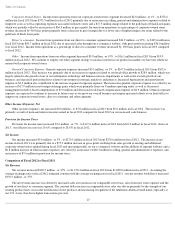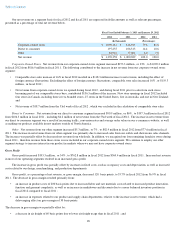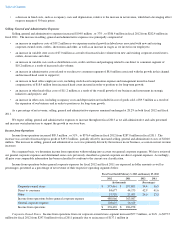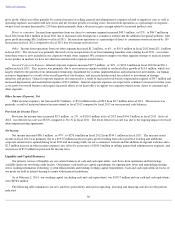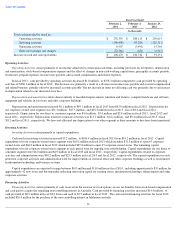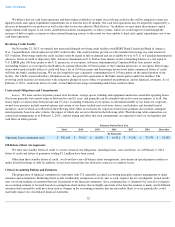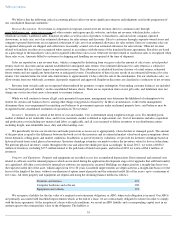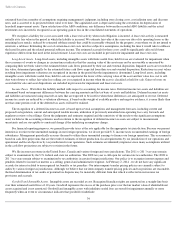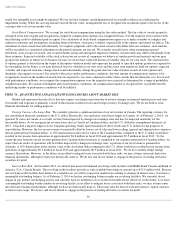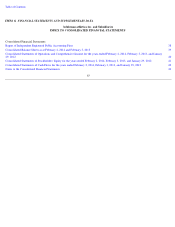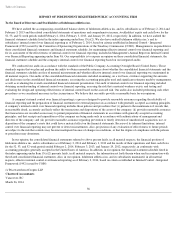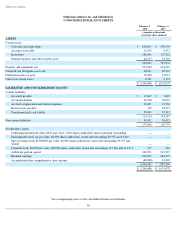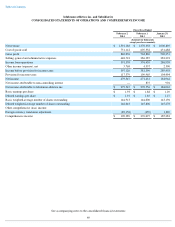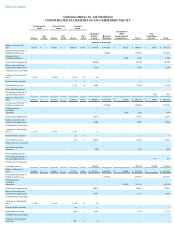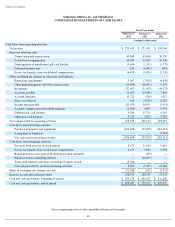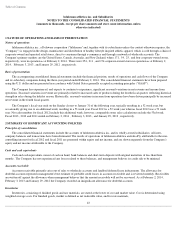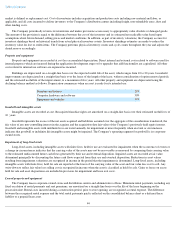Lululemon 2013 Annual Report Download - page 42
Download and view the complete annual report
Please find page 42 of the 2013 Lululemon annual report below. You can navigate through the pages in the report by either clicking on the pages listed below, or by using the keyword search tool below to find specific information within the annual report.
Table of Contents
useful live intangible assets might be impaired. We use our best estimates and judgment based on available evidence in conducting the
impairment testing. When the carrying amount exceeds the fair value, an impairment loss is recognized in an amount equal to the excess of the
carrying value over its fair market value.
Stock-Based Compensation. We account for stock-based compensation using the fair value method. The fair value of awards granted is
estimated at the date of grant and recognized as employee compensation expense on a straight-line basis over the requisite service period with
the offsetting credit to additional paid-in capital. Our calculation of stock-based compensation requires us to make a number of complex and
subjective estimates and assumptions, including future forfeitures, stock price volatility, expected life of the options and related tax effects. The
estimation of stock awards that will ultimately vest requires judgment, and to the extent actual results differ from our estimates, such amounts
will be recorded as a cumulative adjustment in the period estimates are revised. We consider several factors when estimating expected
forfeitures, such as types of awards, size of option holder group and anticipated employee retention. Actual results may differ substantially from
these estimates. Expected volatility of the stock is based on our review of companies we believe of similar growth and maturity and our peer
group in the industry in which we do business because we do not have sufficient historical volatility data for our own stock. The expected term
of options granted is derived from the output of the option valuation model and represents the period of time that options granted are expected to
be outstanding. In the future, as we gain historical data for volatility in our own stock and the actual term employees hold our options, expected
volatility and expected term may change which could substantially change the grant-date fair value of future awards of stock options and,
ultimately, the expense we record. For awards with service and/or performance conditions, the total amount of compensation expense to be
recognized is based on the number of awards that are expected to vest and is adjusted to reflect those awards that do ultimately vest. For awards
with performance conditions, we recognize the compensation expense over the requisite service period as determined by a range of probability
weighted outcomes. For awards with market and or performance conditions, all compensation expense is recognized if it is probable that the
underlying market or performance conditions will be fulfilled.
ITEM 7A. QUANTITATIVE AND QUALITATIVE DISCLOSURES ABOUT MARKET RISK
Market risk represents the risk of loss that may impact our financial position due to adverse changes in financial market prices and rates.
Our market risk exposure is primarily a result of fluctuations in interest rates and foreign currency exchange rates. We do not hold or issue
financial instruments for trading purposes.
Foreign Currency Exchange Risk. We currently generate a significant portion of our net revenue in Canada. The reporting currency for
our consolidated financial statements is the U.S. dollar. Historically, our operations were based largely in Canada. As of February 2, 2014 , we
operated 54 stores in Canada. As a result, we have been impacted by changes in exchange rates and may be impacted materially for the
foreseeable future. As we recognize net revenue from sales in Canada in Canadian dollars, and the U.S. dollar has strengthened during fiscal
2013 , it has had a negative impact on our Canadian operating results upon translation of those results into U.S. dollars for the purposes of
consolidation. However, the loss in net revenue was partially offset by lower cost of sales and lower selling, general and administrative expenses
that are generated in Canadian dollars. A 10% depreciation in the relative value of the Canadian dollar compared to the U.S. dollar would have
resulted in lost income from operations of approximately $0.8 million in fiscal 2013 and approximately $5.5 million in fiscal 2012 . To the
extent the ratio between our net revenue generated in Canadian dollars increases as compared to our expenses generated in Canadian dollars, we
expect that our results of operations will be further impacted by changes in exchange rates. A portion of our net revenue is generated in
Australia. A 10% depreciation in the relative value of the Australian dollar compared to the U.S. dollar would have resulted in lost income from
operations of approximately $0.3 million in fiscal 2013 and approximately $0.9 million in fiscal 2012 . We do not currently hedge foreign
currency fluctuations. However, in the future, in an effort to mitigate losses associated with these risks, we may at times enter into derivative
financial instruments, although we have not historically done so. We do not, and do not intend to, engage in the practice of trading derivative
securities for profit.
Interest Rate Risk.
In November 2013, we entered into unsecured demand revolving credit facilities with HSBC Bank Canada and Bank of
America, N.A., Canada Branch. The revolving credit facilities provide us with available borrowings in amount up to $15.0 million total. Because
our revolving credit facilities bear interest at a variable rate, we will be exposed to market risks relating to changes in interest rates, if we have a
meaningful outstanding balance. As of February 2, 2014 we had no outstanding balances under our revolving facilities. We currently do not
engage in any interest rate hedging activity and currently have no intention to do so in the foreseeable future. However, in the future, if we have
a meaningful outstanding balance under our revolving facility, in an effort to mitigate losses associated with these risks, we may at times enter
into derivative financial instruments, although we have not historically done so. These may take the form of forward contracts, option contracts,
or interest rate swaps. We do not, and do not intend to, engage in the practice of trading derivative securities for profit.
35


